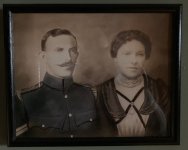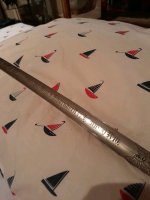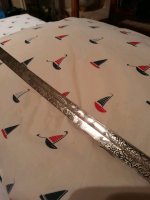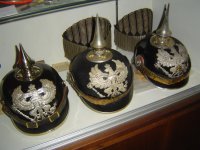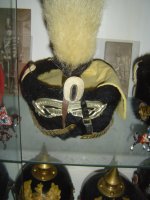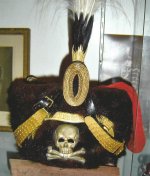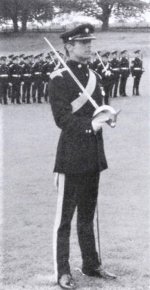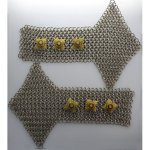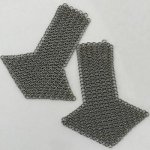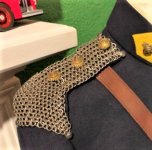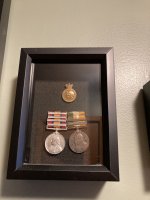The subject of this post, number 7, is a brief history of the Essex Yeomanry, through the end of World War One and an associated 1871 pattern officer’s Essex Regiment full dress dragoon helmet from my dragoon helmet collection owned by Major Andrew Roddick, acing second-in-command of the Essex Yeomanry killed-in-action at Frezenberg Ridge, Ypres, Belgium, on 13 May 1915.
The Essex Yeomanry was a reserve unit of the British Army that originated in 1797 as local yeomanry cavalry troops in Essex. Reformed after the experience gained in the Second Boer War, it saw active service as cavalry in World War One and as artillery in World War Two. Its lineage is maintained by 36 (Essex Yeomanry) Signal Squadron, part of 71 (Yeomanry) Royal Signals regiment, Royal Corps of Signals.
After Britain was drawn into the French Revolutionary wars the government of prime minister William Pitt, the younger, proposed on 14 March 1794 that the counties should form corps of yeomanry cavalry that could be called on by the King to defend the country against invasion or by the Lord Lieutenant to subdue any civil disorder within the county. Prominent landowners came forward to recruit the new force. The first troop of yeomanry in Essex was formed in 1797 by John Conyers of Copped Hall near Epping. The 2nd Troop was recruited in the Chelmsford district in February 1798 by William Tufnell of Langley’s at Great Waltham and the 3rd Troop was raised in March by John Archer-Houblon of Great Hallingbury By the end of May that year there were 15 Troops across Essex, with an establishment of 640 men.
In 1803, when the short-lived Peace of Amiens broke down and the Napoleonic Wars began, there was a resurgence in recruiting for the Yeomanry, and by December that year there were 23 Troops in Essex, with a strength of 1251 men. The largest was the 5th Troop raised at Harlow by Montagu Burgoyne, which had 160 men on its establishment. By 1813 the threat from France had disappeared and the Yeomanry were in decline. The number of troops in Essex had fallen to 12. The government suggested that the independent troops should be regimented, and in February seven of the Essex troops became the 1st Essex Yeomanry Cavalry under the command of Lieutenant Colonel Archer-Houblon. The remaining Troops continued as parts of independent units: 1st Squadron of Essex Yeomanry Cavalry (Captain Conyers), Essex Union Legion Cavalry (Lt-Col Burgoyne), Havering Yeomanry Cavalry (Major Crosse), 1st East Essex Cavalry (Captain Bawtree).
After the Battle of Waterloo, the Yeomanry were kept in being in case of civil disorder, but there was little unrest in Essex and by 1827 only four Troops remained in the county, with a strength of just 120. When Government support for the Yeomanry was withdrawn in 1828 the Tufnell Troop was the last to be disbanded. However, just two years later a wave of unrest swept the country and the government restored Yeomanry pay for drills and periods of service in aid of the civil power. George Palmer of Nazeing Park raised a new Troop known as the West Essex Corps of Yeomanry Cavalry, whose primary purpose was to protect the Waltham Abbey Royal Gunpowder Mill and the Royal Small Arms Factory at Enfield Lock.. From 1838 to 1843 Lt-Col Palmer had to bear the costs of the unit himself. It eventually grew to five Troops as the West Essex Regiment of Yeomanry Cavalry: A Troop (Captain Jessopp) at Waltham Abbey, B Troop (Major J.W.P. Watlington) at Harlow, C Troop (Captain the Hon Francis Petre) from the estates of Lord Petre, D Troop (Light Artillery) (Captain S. Bolton Edenborough of Thrift Hall) at Waltham Abbey, E Troop (Light Artillery).
Lieutenant-Col Palmer retired from the command in 1868 and was followed by a series of commanding officers in quick succession. In 1871 the declining unit reverted to its old title of Essex Yeomanry Cavalry. The government ordered the disbandment of the artillery troops in 1876, and when there were only 46 men on parade in September that year it ordered Lieutenant Colonel T. Duff Cater, to wind up the whole unit and It was disbanded on 31 March 1877. Yeomanry activity in the county did not entirely disappear, Captain Richard Colvin raised an Essex Troop of the Loyal Suffolk Hussars in 1889.
Following a string of defeats during “Black Week” in early December 1899, the British government realized that it would need more troops to re-enforce the regular army to fight the Second Boer War. On 13 December, the decision to allow volunteer forces to serve in South Africa was made, and a Royal Warrant was issued on 24 December. This officially created the Imperial Yeomanry The force was organized as county service companies of approximately 115 men each who signed up for one year service, and volunteers from the Yeomanry and civilians quickly filled the new force, which was equipped to operate as mounted infantry. The Loyal Suffolk Hussars raised the 43rd and 44th (Suffolk) Companies, including volunteers from the Essex Troop. These two companies, which landed in South Africa on 23 February and 28 March respectively, served in 12th Battalion, Imperial Yeomanry. In addition, Lieutenant Colonel Colvin of the Essex Troop commanded the 20th (Rough Rider) Battalion, Imperial Yeomanry, which was raised on 17 March 1900 in the City of London and landed in South Africa on 3 May. The First Contingent of the Imperial Yeomanry completed their year's term of service in 1901, and Lt-Col Colvin was Mentioned in Dispatches and awarded a Champion of the Bath.
The Imperial Yeomanry concept was considered a success and before the war ended the existing Yeomanry regiments at home were converted into Imperial Yeomanry, and new regiments raised, including the Essex Imperial Yeomanry. The Lord Lieutenant, the Earl of Warwick, who became the unit's Honorary Colonel, appointed Lt-Col Colvin to raise and command the new regiment. Colvin arranged the squadrons on the basis of fox hunts in the county, giving the following organization: Regimental Headquarters (Major John Patterson, DSO, as adjutant) at 17 Sir Isaac's Walk, Colchester, A Squadron (Major Henry Lermitte, retired captain in the Royal Scots Fusiliers) at Colchester, with detachments at High Street, Harwick, Marine Hall, Old Pier Street, Walton-on-the-Naze, Ardliegh and Clacton-on-Sea (No 4 Troop at Warwick Castle Hotel, drill hall at Osborne Hotel)– from the Essex and Suffolk Hunt, B Squadron (Major Edmund Deacon, retired Lieutenant in the 1st Kings Dragoon Guards at Drill Hall, Victoria Street, Braintree, with detachments at Queen's Hall, 47 New Street, Halstead, Chelmsford and Tiptree – from the East Essex Hunt, C Squadron (Major Leonard Pelly, former lieutenant in the 20th (Rough Riders) Bn, IY) at Honey Lane, Waltham Abbey, with detachments at Forest Road, Loughton, Bishops’ Stortford, Hertfordshire and Great Dunmow – from the Essex Hunt, D Squadron (Major Francis Whitmore of Orsett Hall, formerly of the 1st Essex Artillery Volunteers) at Drill Hall, East Street, Southend-On-Sea with detachments at Drill Hall, Ongar Road, Brentwood, Artillery Drill Hall, Brook Road, Grays Stratford and Orsett– from the Essex Union Hunt, Honorary Chaplin, Henry Johnson, Bishop of Colchester (former Coronet in the1st Royal Dragoons).
The Boer War was still going on, and further volunteers went out to South Africa with the second contingent of the IY. Major J.H. Patterson, DSO, of the Essex Imperial Yeomanry, was appointed Temporary Lt-Col to command the 33rd Battalion on 17 January 1902. The Imperial Yeomanry were merged into the new Territorial force under the Haldane Reforms of 1908. The regiment simply dropped 'Imperial' from the title and was designated as Dragoons when Lieutenant-Col Colvin handed over command of the regiment to Lt-Col 'Ned' Deacon in February 1911.
In accordance with the Territorial and Reserve Forces Act of 1907 brought the Territorial Force into being. It was intended to be a home defense force for service during wartime and members could not be compelled to serve outside the country. However, on the outbreak of World War One on 4 August 1914, many members volunteered for “Imperial Service.” Therefore, Territorial Force units were split in August and September 1914 into 1st Line (liable for overseas service) and 2nd Line (home service for those unable or unwilling to serve overseas) units. Later, a 3rd Line was formed to act as a reserve, providing trained replacements for the 1st and 2nd Line regiments and the Essex Yeomanry was thus organized. The 1st Line regiment was mobilized at Colchester on the outbreak of war and, with the Easter Mounted Brigade joined the 1st Mounted Division in the Ipswich area. By the end of August 1914 it was in the Woodbridge area. The CO reported that the men were all medically fit, fully trained, and aged 19 years or older, and the regiment was accepted for overseas service. However, delays in obtaining replacement kit and new saddles delayed the regiment's departure for the Western Front until late November, and it just missed being eligible for the “Mons Star” issued to the “Old Contemptibles.”
The regiment landed at Le Havre on 1 December 1914 and joined the Royal Horse Guards and the 10th Royal Hussars in France on 12 December 1914 as part of 8th Cavalry Brigade,3rd Cavalry Division near Hazebrouck.. It remained on the Western Front for the rest of the war
After mobilization the Essex Yeomanry reorganized on a three-squadron basis: RHQ: 6 officers and 34 men, commanded by Lt-Col Deacon, A Sqn: Colchester, Ardleigh Harwich, Clacton and Walton-on-the-Naze Troops, with the South-end Troop from D Sqn – 6 officers and 136 men commanded by Major Eustace Hill, B Sqn: Braintree and Finchingfield, Tiptree and Maldon, Halstead and Chelmsford Troops, with the Orsett Troop from D Sqn – 6 officers and 138 men commanded by Major Guy Gold, C Sqn: Waltham Abbey, Epping, Dunmow and Bishop's Stortford Troops, with the Brentwood and Stratford Troop from D Sqn – 6 officers and 135 men commanded by Major Andrew Roddick (the owner of the helmet subject of this post), Machine Gun Section – 25 men commanded by Lieutenant Tom Buxton.
The regiment saw its first action at the Battle of Frezenberg Ridge, Ypres, Belgium, on 13 May 1915, when in pouring rain it made a dismounted bayonet charge that recaptured disputed German front line trenches. Following three weeks of heavy fighting which included the use of chlorine gas the Essex Yeomanry were moved into a support position at the strategically important Frezenberg Ridge. Their main task was to dig a communications trench to ease communications between the front line and GHQ. At 4:00 am the Germans started a bombardment which lasted four hours and damaged the defensive trenches held by the 2nd Lifeguards, Prince Albert’s Own Leicestershire Yeomanry and the 3rd (Prince of Wales’s) Dragoon Guards. The German offensive took the trenches held by the 1st Lifeguards and desperate fighting took place. Reinforcements were called for and the Essex Yeomanry, The Horse Guards and the 10th Royal Hussars charged the trenches and drove back the German offensive. But having suffered substantial casualties from artillery fire, it was ordered to withdraw with the rest of the brigade. All told it suffered 51 killed, 91 wounded and 19 missing: a total of 161out of 302 who went into action. Among the dead were the Commanding Officer, Lieutenant Colonel Deacon, and his acting second-in-command, Major Roddick. Most of the dead, including Lieutenant Colonel Deacon and Major Roddick were buried in unmarked graves and are now commemorated on the Menin Gate Memorial to the Missing at Ypres The regiment later chose Ypres 1915 and Frezenberg as the first two battle honors to be emblazoned on its guidon.
The surviving 149 Yeoman under the command of Major Tony Buxton went into reserve at Hooge . A Regular Army officer, Lieutenant Colonel Wickham of the Kings Dragoon Guards, was brought in as Commanding Officer to train and integrate the replacement drafts into the regiment. Major Whitmore, who had been wounded on the morning of 13 May and thus missed the afternoon assault on Frezenberg Ridge, returned in September and took command with the rank of Lieutenant Colonel. Popularly known as “Brasso” he remained in command until 1918. The regiment was present with the rest of 3rd Cavalry Division defending Loos during the Battle of Loos (26–8 September 1915), but did not see serious action again until 1917. The regimental machine gun section was combined with those of the other regiments to form the 8th Brigade Machine Gun Squadron, Machine Gun Corps on 29 February 1916. The Essex Yeomanry went on to take part in the Battle of the Scarpe that launched the Arras Offensive.
The regiment was reconstituted in 1920 as part of the Territorial Army with regimental headquarters at Colchester. In 1921, the regiment was converted from cavalry to artillery and became the 104th (Essex Yeomanry) Brigade, Royal Field Artillery: Regimental Headquarters was at Colchester, 413 (Essex Yeomanry) Battery was based at Colchester, and 414 (Essex Yeomanry) Battery was based at Harlow.
In 1932, with regimental headquarters and 413 Battery transferred to Chelmsford, the regiment gained 339 (Essex Royal Horse Artillery) Battery based at Colchester, transferred from 85th (East Anglia) Field Brigade. In 1938, the regiment was renamed 104th (Essex Yeomanry) Regiment, Royal Horse Artillery.
The Essex Yeomanry helmet in my collection is an 1871 pattern officers helmet distinctive to the regiment. It is of gilt brass surmounted with a red horse hair plume. The helmet plate is made up of four pieces consisting of the sliver star plate, the gilt band containing the regiments motto, in the center mounted within the motto scroll a silver shield of the arms of Essex, and lastly the gilt regimental title scroll below the star plate, which would be in white metal for other ranks and the center piece is in one stamping in brass containing the motto band and arms of Essex for other rank too. This helmet is complete with its named japanned travel/storage tin with a brass makers plate and brass name plate engraved “Major A. Roddick, Essex Yeomanry.”
Thank you for viewing this helmet and I hope, even though lengthy, you aprriciate the brief regimental history!
Cheers,
David
View attachment 33072
View attachment 33073
View attachment 33074
View attachment 33075
View attachment 33076
View attachment 33077
View attachment 33078
Major Andrew Roddick, Essex Yeomanry, France April 1915
View attachment 33079
Essex Yeomanry Coronation Detachment Coronation of Edward VII
View attachment 33080
Essex Yeomanry Officer Full Dress Circa 1901

